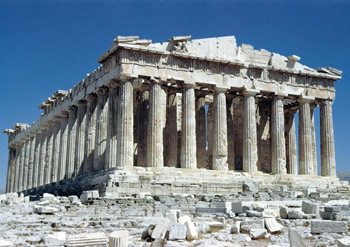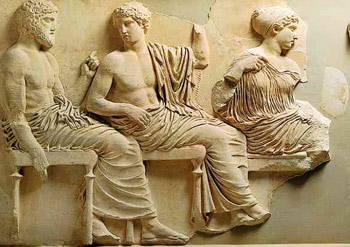The Acropolis

Even though Acropolis is usually connected with Pericles's Era due to the fact that most of its monuments were constructed during that period, the history of the Acropolis dates back to 4,000 AD, when the first inhabitants of Athens settled there. What made that specific point suitable for living was the surface of its top which made easy the construction of the houses while the hill was like a natural fortress against invasions. Moreover, the caves around the hill offered natural protection or housing to the very first people who inhabited the Acropolis. At the same time, there were natural water springs that were vital for the surviving of both humans and their animals.
Later on, Mycenaeans built the palace of their king on Acropolis and expanded its settlement. During the archaic period, the Acropolis ceased being used as the king's place and it was transformed to a religious area where the Festival of Panathinaea took place. The first temples were built during the 6th century and the son of Peisistratus built a temple devoted to Athena Polias, in 525 BC, where a wooden statue of the goddess Athena was placed. The pediment of that temple, depicting a battle among the Giants, is nowadays exposed in the Museum of the Acropolis.

During the Golden Age, the sacred rock of Athens was enriched with various temples. In the beginning of the 5th AD century, Athenians build the Proparthenon, a temple devoted to Athena who was considered to have helped them defeat Persians in the Battle of Marathon. However, the Acropolis was burnt by Persians in 480 BC and Athenians stared repairing its walls using the material of the destroyed monuments and from the Proparthenon Temple. During the second half of that century, Pericles and the talented sculptor Phidias implemented a building program which included the Parthenon and the southern wall of the Acropolis. The Hellenistic Era left a Roman temple behind the Parthenon, devoted to Rome and Augustus by the Romans and a staircase to the Propylaia. Unfortunately, the Acropolis was burnt in 267 AC by Heroulis. During the Byzantine period the ancient monuments of the sacred hill were turned to Christian churches. The Latin Occupation (1204-1458 AC) transformed the temples of the Acropolis into residences of the Latin but and during the Turkish occupation (1458-1821 AC) they were turned to mosques while a minaret was erected in the Parthenon which was used as a gunpowder storehouse during the War between Turkish and Venetians. For that reason, the Venetians se a fire to the Parthenon in 1678, which caused destroying damages to the temple.
A big part of the statues and the monuments of the Acropolis were eliminated and stolen from the rock during the wars. Some of them were sold to rich people or are exposed in foreign countries (i.e. the Elgin Marbles in the British Museum).
Despite that, it remains an archeological site of great importance which attracts thousands of people to admire what has been left from the Golden Age of Athens. At the same time, several restoration works are carried out daily in order to preserve the monuments of that holly rock.
The monuments one can see on the hill of the Acropolis are the Propylaea, the Parthenon and the Erechtheion. The Hill of the Acropolis offers a great view to Athens town.
Hotels near Acropolis
Acropolis can be seen from several points of Athens as it is situated on the top of a hill. However, the most spectacular view to it is during the night thanks to its graet lightening. People who visit Athens usually stay at the roof garden of nearby hotels admiring the Parthenon standing imposing above them. The picturesque neighborhood around the Acropolis is full of cosy hotels that offer a view to the ancient site thus being the most popular Athens hotels. Even though being more expensive than similar hotels that belong to the same category, they are worth paying thanks to their ideal location in the heart of Athens town, by the most important archeological sites and of course close to the most popular restaurants and cafes of Athens.




